
Bonito kick off the nearshore season for Little River area fishermen.
Nothing cures cabin fever like an intense, rod-bending adventure along the South Carolina coast.
Even though they come in relatively small packages, Atlantic bonito launch the spring’s pelagic migration, plowing inshore with a vengeance Although their visit lasts only four to six weeks at best, experienced fishermen never miss an April opportunity to wrangle these football-shaped beasts over the bow of the boat and onto the dinner table.
Although their presence in nearshore waters off Little River is not known by everyone, their arrival and departure follows a regime similar to pelagic fish such as mackerel and tuna — they go where the water temperature suits. them.
“Bonito arrive (around) the nearshore Little River reefs when the water temperatures reach the mid-60s, but they move out as the ocean water temperature reaches the mid-70s,” said Capt. Chris Gill of Go Fish Charters, who makes it through each winter, painfully waiting for the springtime bonito run — which takes place with the Myrtle Beach condo-tels lining the horizon.
“They usually start to show up around nearshore structure between the first and second week of April, and they usually stick around for four to six weeks, but they quickly get replaced by the spring run of Spanish mackerel,” said Gill (843-333-3920).
The arrival of the bonito along South Carolinas shores gives his clients some fast action to kick off the springtime fishing season.
When the water temperature reaches the mid-60s, Gill ventures out to several nearshore locations looking for large groups of baitfish, birds diving, and fish busting the surface. When bonito show up, they let everybody know that they’re on site and ready to eat. The reefs, structure, and other livebottom areas attract large pods of baitfish and schools of hungry bonito.
Gill prefers shallow nearshore reefs and structure at depths from 30 to 45 feet (within 10 to 12 miles of the beach), including the Jim Caudle (AR 435/formerly known as the Little River Inshore Reef), the General Sherman and areas east of the Sherman. Other areas you’ll find bonito include the Little River Offshore Reef, the 65-foot Hole, the 390/390 Rock, AR 460, AR 440, and the 410/510 ledge.
The bonito show up there, Gill said, because those areas will hold big schools of glass minnows, a favorite meal for bonito.
“Most of the bonito we clean have stomachs chocked full of glass minnows,” he said.
During April, glass minnows comprise the only highly available food source in the area. Bonito forage almost exclusively on the thick pods of glass minnows clustered around nearshore reefs and livebottom areas.
Gill isn’t the only crazed captain “dialed-in” on the presence of arriving bonito, Patrick Kelly of Captain Smiley Fishing Charters (843-361-7445) quickly adjusts his strategy when schools of bonito thrash the water. In April, Kelly frequents the Jim Caudle Reef, just three miles from the Little River Inlet. He’s usually in search of doormat flounder, but he keeps his eye out for the characteristic surface activity of feeding bonito. Since the Jim Caudle Reef is spread out over a wide area, schools of glass minnows will be spread between each piece of structure in the reef complex.
“As soon as the bonito show up in the area, I cruise around looking for the feeding birds that set off the feeding frenzy. The birds give away the bonito every time,” Kelly said.
A close cousin to tunas and mackerel, bonito are part of a group of fishes known to travel at considerable rates of speed hunting within schools. Bonito are voracious predators, pushing baitfish to the surface for a quick attack and energy-rich meal. As soon as the bonito bust into the school, the glass minnows scatter and flee in every direction, getting picked off quickly by swarming bonito.
At this point, lure choice and presentation becomes the critical decision for the angler. Bonito will strike most small and shiny lures traveling at a high rate of speed. Since bonito are expecting baitfish to make quick bursts in an attempt to flee, lures should be highly visible and worked with an extremely fast retrieve.
“Any glass minnow imitation lures work great, like sling jigs and fast-action spoons,” said Kelly, who prefers Deadly Dick Diamond lures, Maria Jigs, and Gotcha Lure, usually one-half ounce in size. Since glass minnows tend to reflect light and take on the colors of their surroundings, choice colors will vary. Preferred combinations should have an added amount of flash in blues and greens. GIll, however, sticks with half-ounce Acme Kastmaster spoons in basic silver and gold. He will occasionally use a Yo-Zuri Crystal Minnow F7 Series in silver/black.
Having the right lure tied on is only part of the equation for catching a mess of bonito. Remember, bonito are busting through the baitfish, and the glass minnows are frantically fleeing in every directions at high speeds. Retrieving sling jigs and spoons ultra-fast is an absolute must to draw strikes. Fan casting through and immediately adjacent to the schools can be quite effective.
While casting into schools is productive, trolling can be more effective. Trolling speeds are easily controlled, keeping the lure within the strike zone. Trolling also allows the angler to troll different lures and colors at the same time. The surface-feeding intervals are sometimes short and infrequent, but fish can be caught readily below the surface. Downriggers, No. 1 and 2 planers or weighted lines will get offerings down into the strike zone. Typically, Nos. 0, 00 and 1 gold or silver Clark Spoons are quite effective.
Bonito are like all pelagic fish; they have to swim at fast speeds to pass enough water over their gills or face into swift currents while ambushing prey or traveling; hence, casting lures or trolling with the current will produce more hookups as well.
Bonito are toothy critters, and line protection is a requirement. However, they are less likely to strike a lure tied to an unnatural wire material. Only monofilament or fluorocarbon leaders should be used. Gill prefers to use 24-inch-long leaders of 20-pound clear fluorocarbon material. When trolling deep, longer leaders must be used to hide the hardware that pulls the lures down to the right depths. Leaders should be at least four feet long and lengths of 10 to 15 feet are preferred.
Bonito are exciting to catch, but until recent years, their exquisite food value was not recognized; their dark flesh is similar in flavor to yellowfin tuna. However, isolated groups of little tunny (aka false albacore) will travel with bonito during the spring run. Distinguished by squiggly lines running from mid-body to in front of the tail — bonito have straight-line markings — they should be returned to the sea. Bonito and little tunny are classified within the same family, but their food values are miles apart. The flesh on bonito is dark and firm, and is best grilled, seared, or eaten raw.


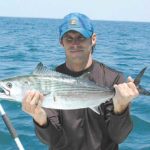

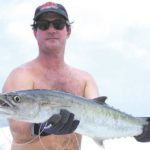
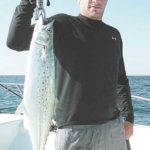
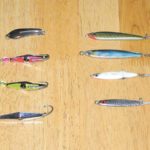
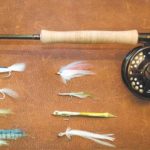



Be the first to comment